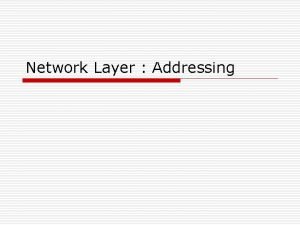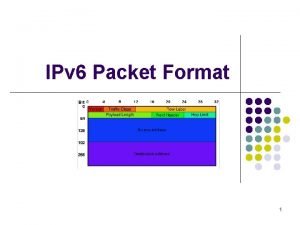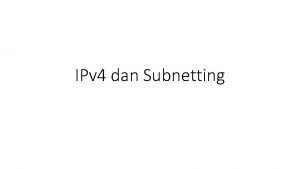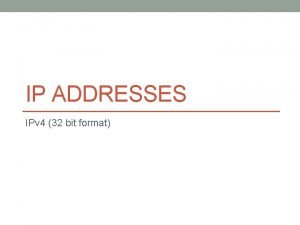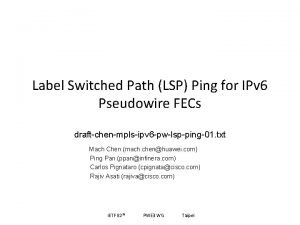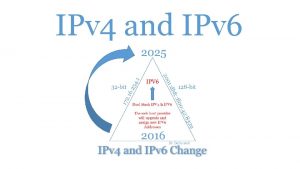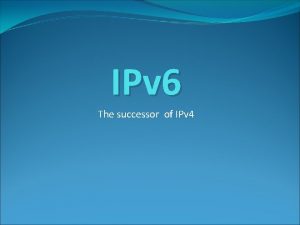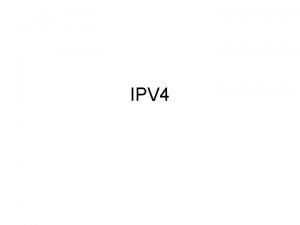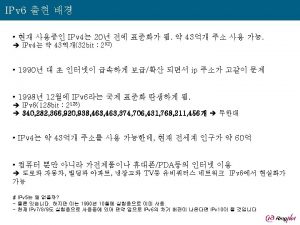IPv 4 and IPv 6 IPv 4 A













- Slides: 13

IPv 4 and IPv 6

IPv 4: A little bit of history IPv 4 has roots from 1974, and it was standardised in 1981 (RFC 791) Obviously, back then no one knew how popular the Internet was going to become.

IPv 4: How an addresses is written An IPv 4 address is written: xxx where xxx is between 0 and 255 (28 = 256) Thus we really have 8 bits between every dot, and 8*4 = 32 bits in total per address 32 bit integer for every unique address: 232 ≈ 4 billion

IPv 4: Addresses in binary form xxxxxxxx x is a bit, namely 0 or 1 Example: 173. 194. 32. 3 (google. com) 10101101 11000010 10000011

IPv 4: Limited address space ~4 billion unique addresses So obviously 4 billion addresses in a world of 7 billion people is going to be problematic. A way to mitigate the problem: * NAT (Network Address Translation)

NAT: Introduction With NAT (Network Address Translation), multiple computers share a single IP address on the Internet. In practise: wireless routers and home routers in general use NAT, since your ISP only gives you a single public IP address

NAT: Usage and problems A possible solution to the limited address space problem in IPv 4 is for ISPs to no longer give each customer a public IP address. The problem with NAT is that individual computers behind a NAT router is not addressable from outside the NAT (from the Internet). This causes problems for peer-topeer services among other things.

NAT: Why is it bad for peer-to-peer? If two users want to connect to each other (not through a third-party server), and both users are behind a NAT, they can't do it without manual configuration of their routers. (They don't have any address to "call" the other party) Bad!

IPv 6: Introduction As a long-term solution, IPv 6 was developed. The main difference from IPv 4 is the new addresses. Example of an IPv 6 address: 2001: 0 db 8: 85 a 3: 0000: 8 a 2 e: 0370: 7334 1000010110100011000000000000

IPv 6: Addresses General IPv 6 address: xxxx: xxxx: xxxx where xxxx is a number in hexadecimal (i. e. base 16, with A-F as additional digits) Results in 128 -bit addresses. 2128 ≈ 3. 4 * 1038

Making sense of big numbers "To put this into perspective: there are currently 130 million people born each year. If this number of births remains the same until the sun goes dark in 5 billion years, and all of these people live to be 72 years old, they can all have 53 times the address space of the IPv 4 Internet for every second of their lives. " - Arstechnica. com article on IPv 6 (http: //arstechnica. com/gadgets/2007/03/i pv 6/2)

IPv 6: Current state of adoption Currently, IPv 4 is practically the only protocol used in the Network Layer. IPv 6 has long been supported in the major operating systems, and in some routers. IPv 6 was enabled on June 6 this year, and it will hopefully grow in usage over the coming years.

Conclusions IPv 4 advantages: * Easier to write the shorter IP addresses * It's in use, so no costly transition IPv 6 advantages: * "Neverending" address pool * No need for NAT and associated problems * Other improvements (like simpler for routers)

